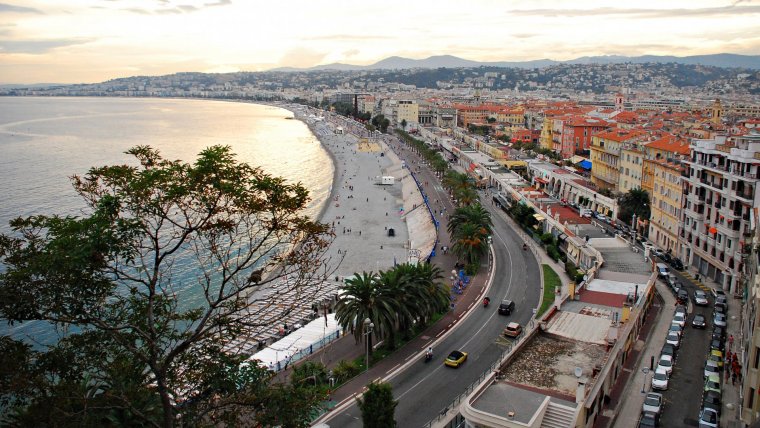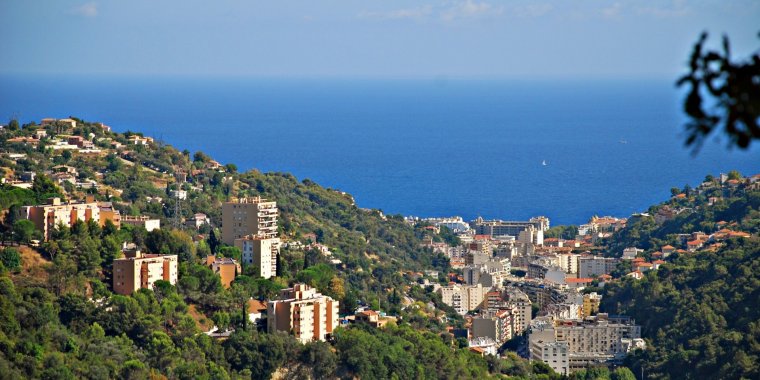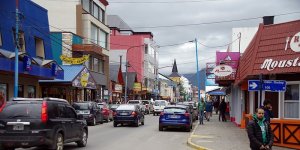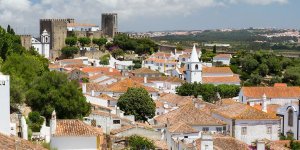| Published in Destinations |
Nice, France

Promenade des Anglais, Nice. Photo: Cătălin Kislinger / Titi Tudorancea Bulletin.
Nice (Nissa, Nizza) is the fifth most populous city in France and the capital of the Alpes-Maritimes département. The urban area of Nice extends beyond the administrative city limits, with a population of about 1 million on an area of 721 km2 (278 sq mi).
Located in the French Riviera, on the south east coast of France on the Mediterranean Sea, at the foot of the Alps, Nice is the second-largest French city on the Mediterranean coast and the second-largest city in the Provence-Alpes-Côte d'Azur region after Marseille. Nice is about 13 kilometres (8 miles) from the principality of Monaco, and its airport is a gateway to the principality as well.
The natural beauty of the Nice area and its mild Mediterranean climate came to the attention of the English upper classes in the second half of the 18th century, when an increasing number of aristocratic families took to spending their winters there. The city's main seaside promenade, the Promenade des Anglais ("Walkway of the English') owes its name to visitors to the resort.
For decades now, the picturesque Nicean surroundings have attracted not only those in search of relaxation, but also those seeking inspiration. The clear air and soft light have particularly appealed to some of Western culture's most outstanding painters, such as Marc Chagall, Henri Matisse, Niki de Saint Phalle and Arman. Their work is commemorated in many of the city's museums, including Musée Marc Chagall, Musée Matisse and Musée des Beaux-Arts.
Nice has the second largest hotel capacity in the country and it is one of its most visited cities, receiving 4 million tourists every year. It also has the third busiest airport in France, after the two main Parisian ones. It is the historical capital city of the County of Nice (Comté de Nice).
Climate
Nice has a hot-summer Mediterranean climate, enjoying mild winters with moderate rainfall. It is one of the warmest Mediterranean climates for its latitude. Summers are warm to hot, dry, and sunny. Rainfall is rare in this season, and a typical July month only records one or two days with measurable rainfall.
The temperature is typically above 20 °C (68 °F) and frequently reaches 30 °C (86 °F). The climate data is recorded from the airport, located just metres from the sea.
Summer temperatures, therefore, are often higher in the city. The average maximum temperature in the warmest months of July and August is about 27 °C (81 °F). The highest recorded temperature was 37.7 °C (99.9 °F) on 1 August 2006.
Autumn generally starts sunny in September and becomes more cloudy and rainy towards October, while temperatures usually remain above 20 °C (68 °F) until November where days start to cool down to around 17 °C (63 °F).
Winters are characterised by mild days (11 to 17 °C (52 to 63 °F)), cool nights (4 to 9 °C (39 to 48 °F)) and variable weather. Days can be either sunny and dry or damp and rainy. Frost is unusual and snowfalls are so extremely rare that they are remembered by inhabitants as special events. The average minimum temperature in January is around 5 °C (41 °F).
Spring starts mild and rainy in late March, and is increasingly warm and sunny towards June.
What to see in Nice
• The greatest thing to see in Nice is the views along the Promenade des Anglais, which skirts the seacoast for over 5 km, then ends at Nice Airport. These are the views you will have seen in dozens of postcards and in paintings by the 20th-century artist, Henri Matisse, who spent so many years living in Nice, but whether you've seen pictures or not, you owe it to yourself to walk along some of this stretch if you have made it to Nice.
• The Hotel Negresco on the Promenade des Anglais was named after Henri Negresco (1868–1920) who had the palatial hotel constructed in 1912. In keeping with the conventions of the time, when the Negresco first opened in 1913 its front opened on the side opposite the Mediterranean.
• Another place worth mentioning is the small street parallel to the Promenade des Anglais, leading from Nice's downtown, beginning at Place Masséna and running parallel to the promenade in the direction of the airport for a short distance of about 4 blocks. This section of the city is referred to as the "Zone Pietonne", or "Pedestrian Zone". Cars are not allowed (with exception to delivery trucks), making this avenue a popular walkway.
Here, tourists can find a fine selection of restaurants, specializing in various types of cuisine, including Niçoise, French, Japanese, Chinese, Vietnamese, Spanish and Italian. There is also a large selection of cafés where one can sit and enjoy an apéritif, as well as several bakeries with coffee, cake, and a terrace. There are also plenty of small shops selling clothing, shoes, and souvenirs.
• Colline du Château. The castle hill overlooking the Baie des Anges and harbour offers a spectacular vantage point overlooking the city. Not much is left of its ruined castle besides crumbling walls. Still, climbing up the stairs to reach the platforms 90 metres above Nice is well worth the view. There is also a lift (ascenseur) which will take you three quarters of the way up. Be aware that the castle hill park closes at around sunset. Expect to be escorted outside if you stay longer.
Nice is also known for several museums. Some of the most famous are in Cimiez, the older, upper part of the city which in a previous century was a favourite of Queen Victoria, including:
• Musée des Arts asiatiques, 405, Promenade des Anglais (Just across the street from the airport), ☎ +33 492 293700. 2 May to 15 October: 10:00-18:00; 16 October to 30 April: 10:00-17:00. Indian, Chinese, Southeast Asian, and world art in great architecture on a lake. Free visit, conference, Qi Gong and Tai Chi Chuan.
• Parc Phoenix, 405 Promenade des Anglais, ☎ +33 4 92 29 77 00, fax: +33 492 29 7701, e-mail: parcphoenix@ville-nice.fr. daily, Apr-Sep, 09:30-19:30, Oct-Mar: 09:30-18:30. 2500 different plants in botanical garden and tropical glass house. Also various animals. €2.
• Musée Marc Chagall, Avenue du Docteur Ménard 36, ☎ +33 4 93 53 87 28, e-mail: visiteguide-mn06@culture.gouv.fr. 10:00-18:00; Nov-Apr: 10:00-17:00; Jan 01,May 01,Dec 25 off. Even if you are not into art this is a museum which should not be missed. It includes stained glass windows by the artist. Full rate : €8, Reduced rate : €6, Free: Students below 26 and for everybody every first Sunday of the month.
• Musée Matisse, 164, Avenue des Arènes de Cimiez (Buses 15, 22, 17, 20), ☎ +33 4 9381 0808, fax: +33 4 9353 0022, e-mail: matisse@ville-nice.fr. daily except Tu, 10:00-16:00. Charming collection of paintings, drawings and sculptures in 17th century Genoese villa €10.
• Musée d'Archeologie de Nice (Next to the Matisse museum), ☎ +33 4 9381 5957, fax: +33 4 9381 0800, e-mail: musee.archeologique@ville-nice.fr. daily except Tu, 10:00-18:00. The ruins of the Gallo-Roman settlement in Cimiez, plus a museum with nice documentation on Gallo-Roman life (but mostly not in English). Activities for children. Free entry; €3 guided tours.
• The old town (Vieux Nice) beneath the hill is a maze of streets and alleys, with many picturesque houses, boutiques and home to the daily flower and fruit market of the Cours Saleya. In addition, the local cathedral, the Baroque Cathédrale Sainte-Réparate, in the heart of Vieux Nice, is pretty. You'll want to walk through the Place Sainte-Réparate, anyway, while you're in the old city. If the doors are open, go in and look at the interior and paintings.
• Near the central bus terminal, there is also the Museum of Modern and Contemporary Art (MAMAC) with four connected towers featuring modern and contemporary artists and their sculptures, paintings, and conceptual installations. Its open-air roof terraces offer one of the best panoramas of the city.
• To the west, there is the Musee des Beaux-Arts housing an excellent collection of pastels and other works by Jules Cheret, among other artists.
What to do in Nice
• Beaches. If you go to Nice for bathing or general lounging on the beach, you may wish to think again. The beaches of Nice consist entirely of large flat stones (gallets). A few private beaches have added a layer of sand, but the free public beaches are a stony experience. Besides towels or mats, you should definitely bring sandals, since walking on the stones can be painful, and a cushion if you want to sit. Free showers are provided on all public beaches and there is a beach volleyball area that is netted off with white sand.
Although the beaches are mainly pebbles it is important to note that many visitors enjoy the beautiful light blue sea for a swim. If you can bear to walk for a few steps on the pebbles it is definitely an opportunity for swimming rather than playing in the water as the beach drops quickly and the tidal pull can be very strong, and not for beginners.
Lying on the beach for a sun tan or relaxation is also manageable as long as you rearrange the rocks/pebbles to a comfy surface for sitting and lying. Private beaches offer various services from restaurants/bars to the rental of lounge chairs and towels.
Much nicer beaches exist in other towns close by, such as Villefranche-sur-Mer, Antibes and Cannes, which are far more sandy. Villefranche is a particularly preferred beach choice, especially if travelling with children, only twenty minutes away by the TAM 100 bus.
However, for walks by the seaside with great views, the Promenade des Anglais is arguably unparalleled.
• Beautiful landscapes. For views of Nice the best vantage point is the heights of Mont Boron (bus 14). From the derelict old Fort and the nearby villa of Sir Elton John there are fine views over the city to the mountains and east over Villefranche and Cap Ferat.
• Go to Eze. It is a small village on the way to Monaco. The village is situated on a small mountain and there is a beautiful cactus garden with a spectacular view (a must see, €5 entrance fee). There is also Fragonard perfume factory which you can visit for free. To reach Eze by bus, take the 112 to Eze Village (not the 100 which stops at Eze Gare, a 90 minute steep walk away from Eze Village).
If you missed an infrequent (up to 3 hours) 115 bus in Eze Village, there is a path that goes down the mountain from Eze Village to Eze Sur Mer (also Eze Gare). This is the Path of Nietzsche (named after the famous German philosopher Friedrich W. Nietzsche), with some fantastic views and a waterfall (if you know where to look). Walking downhill through this path takes about 40 minutes. Buses run from Menton-Monaco through Eze Gare back to Nice every 15 minutes or so and vice versa, making treking back up the hill unnecessary.
• Also close by is the magnificent Villa Ile de France, of the Baroness Ephrussi de Rothschild, straddling the magnificent peninsula of St Jean Cap Ferrat in the so-called Golden Triangle of Villefranche, Beaulieu and Cap Ferrat.
• Hiking trails emanate from La Turbie high above Monaco and the Grande Corniche, which are double the height above sea level of Eze and offer the hardened walker truly spectacular vantage points over the Riviera.
• Cliff Walk. If you go past the old port (probably 15 minute walk) heading east toward Monaco, there is a little pathway that leads from Coco Beach along the side of the cliff, the "Sentier Littoral" which you can follow around Cap de Nice half way to Villefranche, but be prepared for several hundred steps up to rejoin the road. It’s a very beautiful walk and you will find mostly local people using it.
• Live performances. Opéra Nice Cote d'Azur, 4 & 6 rue Saint-François de Paule (In Vieux Nice near the Cours Saleya. Free parking at Palais de Justice and Cours Saleya), ☎ +55 04 92 17 40 00, e-mail: patrick.cavallin@ville-nice.fr. This opera house hosts not only opera performances but also many concerts of the Orchestre Philharmonique de Nice and chamber music recitals, and some ballet performances. The house's website is in French only, but even if you don't read French well, you should be able to make out the information on their calendar (calendrier).
Squares
• Place Masséna. The Place Masséna is the main square of the city. Before the Paillon River was covered over, the Pont-Neuf was the only practicable way between the old town and the modern one. The square was thus divided into two parts (North and South) in 1824. With the demolition of the Masséna Casino in 1979, the Place Masséna became more spacious and less dense and is now bordered by red ochre buildings of Italian architecture.
The recent rebuilding of the tramline gave the square back to the pedestrians, restoring its status as a real Mediterranean square. It is lined with palm trees and stone pines, instead of being the rectangular roundabout of sorts it had become over the years. Since its construction, the Place Masséna has always been the spot for great public events.
It is used for concerts, and particularly during the summer festivals, the Corso carnavalesque (carnival parade) in February, the military procession of 14 July (Bastille Day) or other traditional celebrations and banquets.
The Place Masséna is a two-minute walk from the Promenade des Anglais, old town, town centre, and Albert I Garden (Jardin Albert Ier). It is also a large crossroads between several of the main streets of the city: avenue Jean Médecin, avenue Félix Faure, boulevard Jean Jaurès, avenue de Verdun and rue Gioffredo.
• Place Garibaldi. The Place Garibaldi also stands out for its architecture and history. It is named after Giuseppe Garibaldi, hero of the Italian unification (born in Nice in 1807 when Nice was part of the Napoleonic Empire, before reverting to the Kingdom of Piedmont-Sardinia).
The square was built at the end of the 18th century and served as the entry gate to the city and end of the road to Turin. It took several names between 1780 and 1870 (Plaça Pairoulièra, Place de la République, Place Napoléon, Place d'Armes, Place Saint-Augustin, Piazza Vittorio) and finally Place Garibaldi in September 1870.
A statue of Garibaldi, who was fiercely in favour of the union of Nice with Italy, stands in the centre of the square. The recent rebuilding of the area to accommodate the new tramway line gave mostly the entire square to pedestrians. The architecture is in line with the Turin model, which was the norm of urban renewal throughout the entire realm of the House of Savoy.
It is a crossroads between the Vieux Nice (old town) and the town centre. Place Garibaldi is close to the eastern districts of Nice, Port Lympia (Lympia Harbour), and the TNL commercial centre. This square is also a junction of several important streets: the boulevard Jean-Jaurès, the avenue de la République, the rue Cassini and the rue Catherine-Ségurane.
• Place Rossetti. Entirely enclosed and pedestrianised, this square is located in the heart of the old town. With typical buildings in red and yellow ochres surrounding the square, the cathédrale Sainte-Réparate and the fountain in the centre, place Rossetti is a must-see spot in the old town.
By day, the place is invaded by the terraces of traditional restaurants and the finest ice-cream makers. By night, the environment changes radically, with tourists and youths flocking to the square, where music reverberates on the walls of the small square. The square's lighting at night gives it a magical aspect.
Place Rossetti is in the centre of the old town, streets Jesus, Rossetti, Mascoïnat and the Pont-vieux (old bridge)
• Cours Saleya. The Cours Saleya is situated parallel to the Quai des États-Unis. In the past, it belonged to the upper classes. It is probably the most traditional square of the town, with its daily flower market. The Cours Saleya also opens on the Palais des Rois Sardes (Palace of the Kings of Sardinia). In the present, the court is mostly a place of entertainment. There are good restaurants serving typical Nicois cuisine, markets and many pubs. It is no doubt one of the most active spots in Nice.
• Place du Palais. As its name indicates, the Place du Palais is where the Palais de la Justice (Law courts) of Nice is located. On this square, there also is the Palais Rusca, which also belongs to the justice department (home of the tribunal de grande instance).
The square is also notable due to the presence of the city clock. Today, the Place du Palais is alive day and night. Often, groups of youths will hangout on the steps leading to the Palais de la Justice. Concerts, films, and other major public events frequently occur in this space. It is situated halfway between the Cours Saleya and Place Masséna.
Stay safe
Nice is no more dangerous than other cities in western countries - indeed in many cases it's a lot safer - however, you can stay more safe still following a few pieces of advice:
• Don't even think about getting into an unlicensed "taxi" under any circumstances! That applies doubly so at times like the Film Festival, especially if you are female and have been drinking and partying late.
• Take precautions against pickpockets, who are a constant and serious problem on the Côte d'Azur. They operate usually in teams in any crowded areas like buses, train stations, and tourist sites. Be vigilant at the tram station, Gare Thiers, where pickpockets prey on travel-weary tourists. They may well look like harmless fellow passengers, but they are extremely skilled and will lift your wallet from either your front or back pants pocket without your noticing.
You are strongly advised not to carry anything valuable or annoying to replace in your pockets. Use pouches underneath your clothing for anything valuable, including cash. In restaurants and cafés, opportunist theft of handbags is a constant risk - keep them close at hand.
• If you are travelling by car, take particular care not to leave anything of value in the car when parking. Theft from car boots is a particular issue in underground parking beneath the Nice old town. Leaving the parcel shelf off so that it's clear the boot is empty is a good way to avoid problems.
• Judging from local newspaper reports, personal safety concerns are most likely to arise after 02:30, and visitors should stick to well lit streets with people still around.
If you do fall foul of Nice's criminal practitioners, the National Police Station is where you need to go to report problems such as being pickpocketed. It's at the junction of Ave Marechal Foch and Dubouchage, a couple of hundred metres east of the Nice Etoiles shopping centre. They will supply you with the necessary statements to support insurance claims, but don't expect them to recover your property. You will find the police station very busy with other victims towards the end of the evening. (Wikivoyage/Wikipedia)

Nice. Photo: Cătălin Kislinger / Titi Tudorancea Bulletin.
YOU MAY ALSO LIKE





 If you own or manage a travel-related business such as a hotel, a bed-and-breakfast, a restaurant, a pub or a cafeteria, you can create a web page for your business for free on Titi Tudorancea Travel Info. » |
